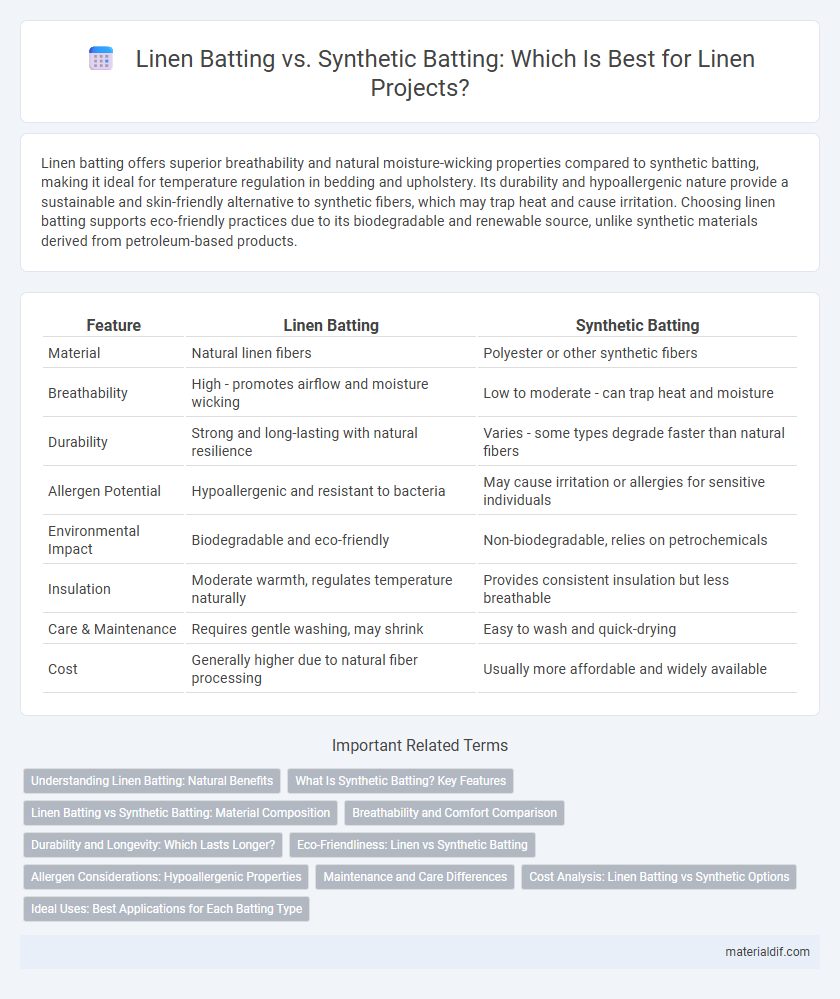Linen batting offers superior breathability and natural moisture-wicking properties compared to synthetic batting, making it ideal for temperature regulation in bedding and upholstery. Its durability and hypoallergenic nature provide a sustainable and skin-friendly alternative to synthetic fibers, which may trap heat and cause irritation. Choosing linen batting supports eco-friendly practices due to its biodegradable and renewable source, unlike synthetic materials derived from petroleum-based products.
Table of Comparison
| Feature | Linen Batting | Synthetic Batting |
|---|---|---|
| Material | Natural linen fibers | Polyester or other synthetic fibers |
| Breathability | High - promotes airflow and moisture wicking | Low to moderate - can trap heat and moisture |
| Durability | Strong and long-lasting with natural resilience | Varies - some types degrade faster than natural fibers |
| Allergen Potential | Hypoallergenic and resistant to bacteria | May cause irritation or allergies for sensitive individuals |
| Environmental Impact | Biodegradable and eco-friendly | Non-biodegradable, relies on petrochemicals |
| Insulation | Moderate warmth, regulates temperature naturally | Provides consistent insulation but less breathable |
| Care & Maintenance | Requires gentle washing, may shrink | Easy to wash and quick-drying |
| Cost | Generally higher due to natural fiber processing | Usually more affordable and widely available |
Understanding Linen Batting: Natural Benefits
Linen batting offers superior breathability and moisture-wicking properties compared to synthetic batting, promoting a cooler and more comfortable sleep environment. Its natural fibers provide enhanced durability and hypoallergenic benefits, reducing irritation for sensitive skin. Unlike synthetic options, linen batting is biodegradable and environmentally sustainable, making it an eco-friendly choice for bedding and upholstery.
What Is Synthetic Batting? Key Features
Synthetic batting is a man-made filling material commonly used in quilting, upholstery, and insulation, crafted from polyester fibers or other synthetic polymers. Key features include lightweight durability, resistance to moisture and mold, consistent thickness, and hypoallergenic properties, making it ideal for bedding and craft projects. Unlike natural fibers like linen batting, synthetic batting provides easier care with machine-washable and quick-drying capabilities.
Linen Batting vs Synthetic Batting: Material Composition
Linen batting is composed of natural flax fibers, renowned for breathability, moisture-wicking properties, and eco-friendliness, whereas synthetic batting typically consists of polyester or other man-made fibers designed for durability and uniform insulation. Linen fibers offer superior temperature regulation and biodegradability compared to synthetic fibers, which may trap heat and hold moisture longer. The natural composition of linen batting makes it an ideal choice for sustainable and hypoallergenic bedding or quilting projects, contrasting with synthetic batting's emphasis on affordability and consistent loft.
Breathability and Comfort Comparison
Linen batting offers superior breathability compared to synthetic batting due to its natural moisture-wicking properties, allowing air to circulate more freely and prevent overheating. This results in enhanced comfort, especially in warm or humid conditions, as linen maintains a cooler sleeping environment. Synthetic batting, while lightweight, often traps heat and moisture, making linen batting the preferred choice for those seeking a breathable and comfortable bedding option.
Durability and Longevity: Which Lasts Longer?
Linen batting outperforms synthetic batting in durability due to its natural fiber strength and resistance to compression over time, making it ideal for long-lasting quilts and upholstery. Synthetic batting, often made from polyester, tends to lose loft and integrity faster under regular use and washing. Choosing linen batting ensures better structural longevity and maintains insulation properties for years, providing a sustainable and reliable option.
Eco-Friendliness: Linen vs Synthetic Batting
Linen batting is highly eco-friendly due to its natural, biodegradable fibers and sustainable flax cultivation that requires minimal water and pesticides. In contrast, synthetic batting relies on petroleum-based materials that contribute to pollution and are not biodegradable, leading to long-term environmental impact. Choosing linen batting supports greener textile production and reduces landfill waste compared to synthetic alternatives.
Allergen Considerations: Hypoallergenic Properties
Linen batting naturally possesses hypoallergenic properties, making it an ideal choice for individuals with sensitive skin or allergies due to its breathable and moisture-wicking fibers that resist dust mites and mold. Synthetic batting, while often treated to be hypoallergenic, may trap heat and moisture, potentially exacerbating allergic reactions over time. Choosing linen batting supports a healthier sleeping environment by reducing exposure to common allergens and promoting better air circulation.
Maintenance and Care Differences
Linen batting offers natural breathability and moisture-wicking properties, making it easier to keep fresh and odor-free with simple air drying and gentle washing, whereas synthetic batting often requires specific cleaning agents and careful handling to avoid clumping or loss of loft. Linen fibers are naturally resistant to mildew and withstand frequent laundering without degrading, while synthetic batting can deteriorate faster under repeated washing cycles and high heat. Choosing linen batting enhances durability and reduces maintenance complexity compared to the higher upkeep demands of synthetic alternatives.
Cost Analysis: Linen Batting vs Synthetic Options
Linen batting typically incurs a higher upfront cost compared to synthetic batting due to its natural fiber sourcing and eco-friendly processing methods. Synthetic batting, often made from polyester or acrylic, offers a more budget-friendly option with lower price points and widespread availability. Considering long-term value, linen batting provides enhanced durability and breathability, potentially reducing replacement frequency despite the initial expense.
Ideal Uses: Best Applications for Each Batting Type
Linen batting excels in natural fiber projects requiring breathability and moisture-wicking properties, making it ideal for eco-friendly quilts, mattress pads, and sustainable upholstery. Synthetic batting offers superior loft and insulation, preferred for cold-weather comforters, lightweight outerwear, and hypoallergenic home furnishings. Choosing linen or synthetic batting depends on desired texture, durability, and specific climate considerations for optimal performance.
Linen Batting vs Synthetic Batting Infographic

 materialdif.com
materialdif.com